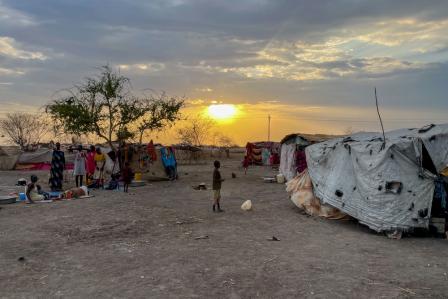South Sudan: A record of the consequences of violence since independence
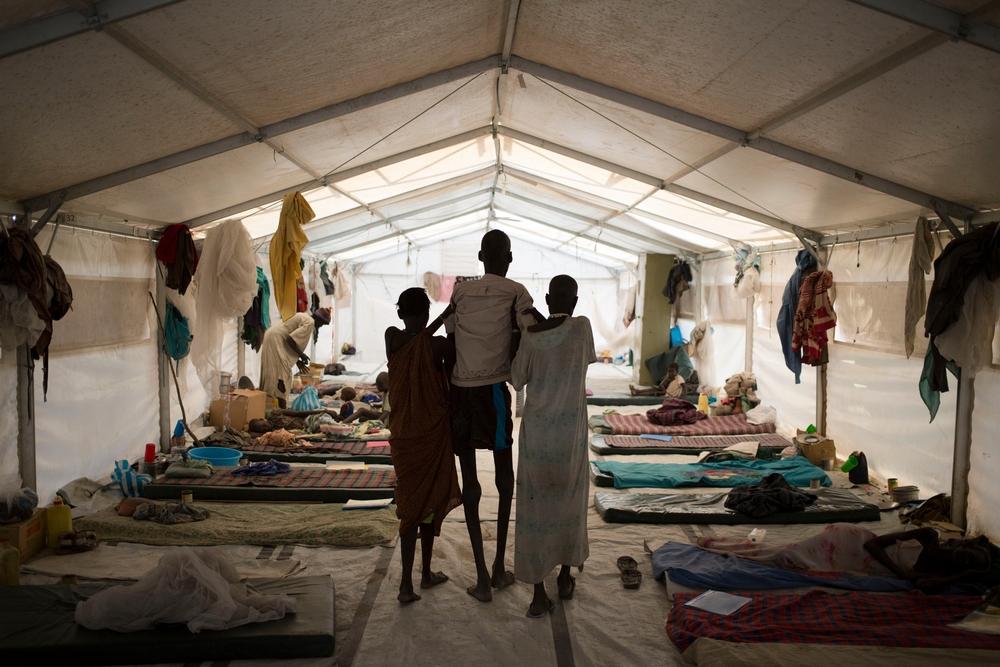
Kala azar sufferer Ruai Puot Malow (56 years) is assisted by his wife Yakuony Jock Deng (right) and a relative at a Doctors Without Borders / Médecins Sans Frontières (MSF) hospital in Lankien, South Sudan, 13 Jan 2015. Ruai was brought to the hospital by relatives who carried him for five hours through the bush to the Doctors Without Borders hospital after he suffered yet another outbreak of the disease. The conflict that erupted in South Sudan little more than a year ago has left people more vulnerable to a deadly tropical disease known as kala azar (visceral leishmaniasis). The risk of infection increases as people are displaced by fighting into areas where the disease is prevalent and malnutrition lowers their ability to fight the infection. With many health facilities not functioning in conflict areas, getting treatment is more difficult. © Karel Prinsloo
A new Doctors Without Borders / Médecins Sans Frontières (MSF) report, South Sudan at 10: an MSF record of the consequences of violence, offers a consolidated account of the Doctors Without Borders experience in South Sudan since 9 July 2011. It seeks to serve as a record and reminder of the human toll of violence since independence, as seen by Doctors Without Borders – through its staff and patients.
Independence to civil war
At independence, South Sudan was grappling with at least 30 humanitarian emergencies. Parts of the country were engulfed in increasingly fierce intercommunal clashes, and there was renewed conflict in border areas with Sudan. Despite the challenges, the first years in the post-independence period were a time of anticipation and optimism and, for most of the country, it was a period of relative peace.
However, by December 2013, less than two years after independence, the country had rapidly imploded into civil war, quickly exposing the fragility of the emerging young state.
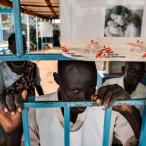 After these 22 years of civil war came, then there came independence in 2011. The whole population was joyous. We were happy because a new country was born... but all this hope and dreams became all of a sudden no more.Yambio, staff member, August 2019
After these 22 years of civil war came, then there came independence in 2011. The whole population was joyous. We were happy because a new country was born... but all this hope and dreams became all of a sudden no more.Yambio, staff member, August 2019
Extreme violence
The five-year conflict is estimated to have led to nearly 400,000 deaths, many the result of ethnically motivated targeting of civilians, including children and the elderly. Sexual and gender-based violence (SGBV) has been used as a weapon of conflict, with systematic ethnically and politically motivated attacks.
Some of the most extreme violence was conducted in places of refuge and sanctuary, including state hospitals, where patients and people seeking shelter were killed in a series of brutal attacks. Millions of people have been displaced, often multiple times, inside and outside South Sudan. This includes hundreds of thousands of people who sought shelter in Protection of Civilian (PoC) sites, inside the bases of the United Nations Mission in South Sudan (UNMISS).
Since independence, 24 of Doctors Without Borders’s South Sudanese staff have been killed by violence, five while on duty. All of Doctors Without Borders’s patients, staff and their communities have been impacted directly and indirectly by conflict and violence.

Nakoch Tiek Koal (23) carries her 1 1/2 year old daughter, Nyachot Gatluok, in her arms and her six-month-old child Kawai in a basket. They have walked for 2 days to reach the UN Protection of Civilians sites in Bentiu, South Sudan. 22 November, 2015. © Dominic Nahr/MAPS
Deaths from preventable diseases
Across the country, people have been subject to destruction, displacement, disease, and death. Violence disrupts access to healthcare, including routine vaccination, while increasing the risk of disease transmission and food insecurity.
There have been repeated failures to ensure dignified living conditions for people in refugee camps and PoC/Internally Displaced Persons (IDP) sites. Instead, people fleeing conflict and violence have, over and again, been forced to live in deplorable conditions – with basic requirements for living space, water and sanitation unmet, far below the minimum emergency thresholds for survival.
At its worst, Doctors Without Borders has recorded three to five children a day dying from preventable diseases – such as malaria – in different refugee camps and PoC sites. Meanwhile, people forced to live in the open, in the bush and swamps, have repeatedly been exposed to disease and extreme hunger.
In some areas, conflict brought a resurgence of kala azar, the world’s second largest parasitic disease. In addition, there have been measles, hepatitis C and cholera outbreaks, amongst others.
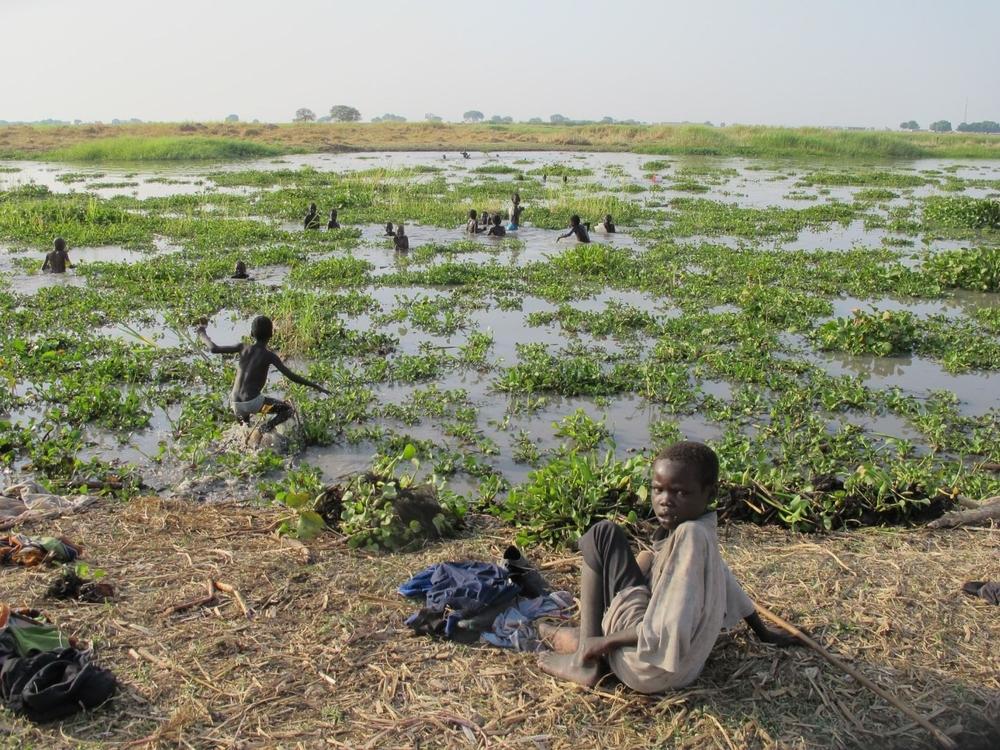
Continuing clashes in Upper Nile state in South Sudan are leading to more deaths and displacements of people. Over 1,665 families, mainly from the Shilluk tribe, have left Melut since the beginning of April and sought refuge in Noon, across the river Nile. They live under trees and have extremely limited access to latrines, leading to open defecation and have to travel long distances to fetch water from the Nile. Kids in Noon take a swim in the Nile when they go and fetch water. South Sudan, April 2015. © Beatrice Debut/MSF
Mental health
Millions of people in South Sudan have been repeatedly exposed to traumatic events. Doctors Without Borders has witnessed increases in suicide attempts and has worked with patients coping with post-traumatic stress disorder.
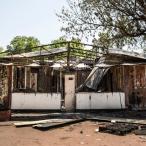 The most difficult thing to be South Sudanese is the fear. People facing in fear. People sleeping in fear. So, this creates a lot of trauma on people because people are not free like when we first got our independence.Mundri, staff, August 2019
The most difficult thing to be South Sudanese is the fear. People facing in fear. People sleeping in fear. So, this creates a lot of trauma on people because people are not free like when we first got our independence.Mundri, staff, August 2019
The impact of protracted conflict and repeated humanitarian crises in South Sudan is worsened by a weak, chronically underfunded, healthcare system, destroyed in many areas and largely neglected in others. In 2020, of approximately 2,300 health facilities, more than 1,300 were non-functional. Less than half (44 per cent) of the total population and just 32 per cent of internally displaced persons live within five kilometres of a functional health facility.
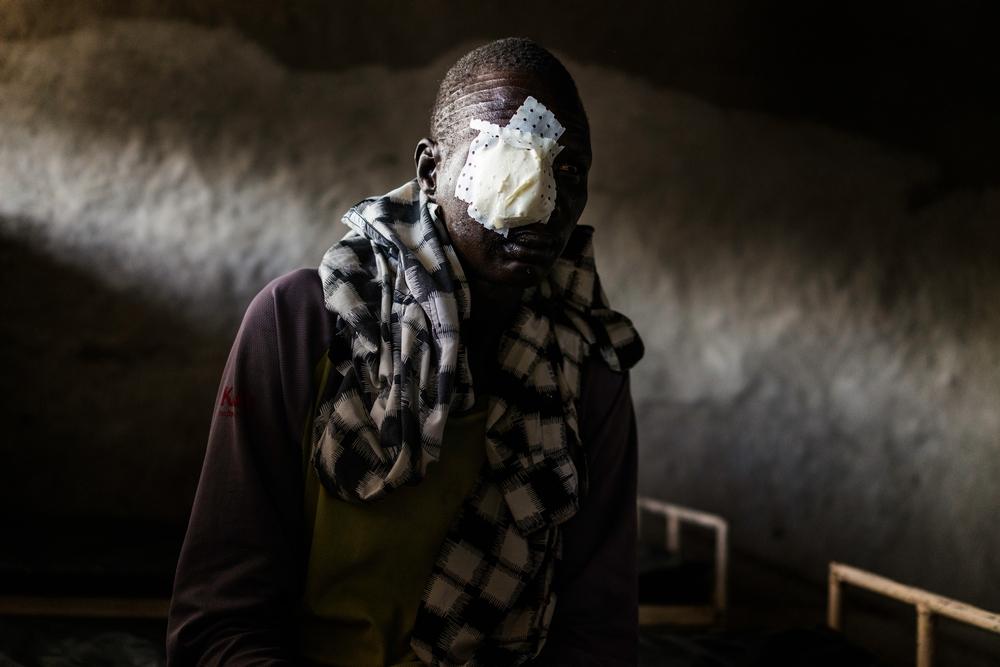
Peter Gatlek (50) sits on a hospital bed after receiving new bandages at the Doctors Without Borders hospital in Lankien. He was shot in the head while trying to escape an attack on his village near Leer 25 days ago. Peter was finally med-evacuated to a Doctors Without Borders hospital. When talking about the experience he says: "They just came and attacked our village. I just ran away and hid myself in the swamp. Some people who ran with me were wounded. Some were killed." South Sudan, November 2015 © Dominic Nahr/MAPS
Continuing humanitarian crises
Despite a peace agreement in 2018 which ended five years of civil war, and the formation of a unified government in early 2020, the situation remains volatile in many areas. In 2019, South Sudan saw a resurgence of subnational conflicts and factional fighting, which has since escalated in 2020 and 2021.
Today, 8.3 million people – more than two-thirds of the population – are estimated to be in dire need of humanitarian assistance and protection. Today, in what is the largest refugee crisis in Africa, 2.2 million South Sudanese people are sheltering in neighbouring countries. More than 1.6 million people remain internally displaced. Even in a best-case scenario, South Sudan will remain vulnerable to humanitarian crises for the foreseeable future and will need assistance for some time.
South Sudan’s leaders must make every effort to ensure civilians' safety and security and an environment conducive to the delivery of humanitarian assistance, independent of any political agenda.
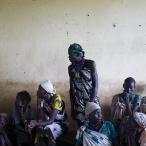 My hope for the future for the next 10 years is a transformed society, a transformed community where we can live and co-exist among ourselves. Where I see someone is my brother. I see someone is my sister … Where I can just move without any restriction. Where I can express my feelings, to anyone, regardless of their race, regardless of their tribe. And this is the society that I'm longing for in the next 10 years … It’s the young generation that will inspire the generation that is coming after us.Staff member, 22 April 2021
My hope for the future for the next 10 years is a transformed society, a transformed community where we can live and co-exist among ourselves. Where I see someone is my brother. I see someone is my sister … Where I can just move without any restriction. Where I can express my feelings, to anyone, regardless of their race, regardless of their tribe. And this is the society that I'm longing for in the next 10 years … It’s the young generation that will inspire the generation that is coming after us.Staff member, 22 April 2021
For nearly 40 years, the area that constitutes South Sudan has been amongst Doctors Without Borders’s highest global priority countries, in terms of operations, employment and financing. As the young nation moves into its next decade, Doctors Without Borders remains committed to the people of South Sudan.

